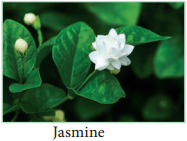Learninsta presents the core concepts of Biology with high-quality research papers and topical review articles.
Cosmetics | Aloe | Perfumes | Jasmine and Its Uses
Traditionally in Southern India, people have been using turmeric, green gram powder, henna, sigaikai and usilai for their skin and hair care. These were mostly home prepared products that are used for grooming. Today, cosmetics have a high commercial value and have become chemical based industrial products. Providing personal care services has become a major industry.
In recent years, people have realized the hazards of chemicalbased cosmetics and are turning back to natural products. In this chapter one of the major plants namely Aloe which is used in the cosmetic industries is discussed.
Aloe
Botanical name: Aloe vera
Family: Asphodelaceae (formerly Liliaceae)
Origin and Area of cultivation:
It is a native of Sudan. It is cultivated on a large scale in Rajasthan, Gujarat, Maharashtra, Andhra Pradesh and Tamil Nadu.

Uses
‘Aloin’ (a mixture of glucosides) and its gel are used as skin tonic. It has a cooling effect and moisturizing characteristics and hence used in preparation of creams, lotions, shampoos, shaving creams, after shave lotions and allied products.
It is used in gerontological applications for rejuvenation of aging skin. Products prepared from aloe leaves have multiple properties such as emollient, antibacterial, antioxidant, antifungal and antiseptic. Aloe vera gel is used in skin care cosmetics.
Perfumes
The word perfume is derived from the Latin word Per (through) and fumus (to smoke), meaning through smoke. It refers to the age-old tradition of burning scented woods at religious ceremonies.
In early days, when people were less conscious of personal hygiene, essential oils not only masked offensive odours, but also may have acted as antiseptics. Perfumes are added to baths and used for anointing the body.
Perfumes are manufactured from essential oil which are volatile and aromatic. Essential oils are found at different parts of the plant such as leaves, (curry leaf, mint), flowers (rose, jasmine), fruits (citrus, straw berry) and wood (sandal, eucalyptus).
Jasmine
Botanical name: Jasminum grandiflrum
Family: Oleaceae
Jasmine, as a floral perfume, ranks next to the rose oil. Major species cultivated on the commercial scale is Jasminum grandiflorum, a native of the north-western Himalayas. In Tamil Nadu, the major jasmine cultivation centres are Madurai and Thvalai of Kanyakumari District.
The essential oil is present in the epidermal cells of the inner and outer surfaces of both the sepals and petals. One ton of Jasmine blossom yields about 2.5 to 3 kg of essential oil, comprising 0.25 to 3% of the weight of the fresh flower.

Uses
Jasmine flowers have been used since ancient times in India for worship, ceremonial purposes, incense and fumigants, as well as for making perfumed hair oils, cosmetics and soaps. Jasmine oil is an essential oil that is valued for its soothing, relaxing, antidepressant qualities.
Jasmine blends well with other perfumes. It is much used in modern perfumery and cosmetics and has become popular in air freshners, anti-perspirants, talcum powders, shampoos and deodorants.